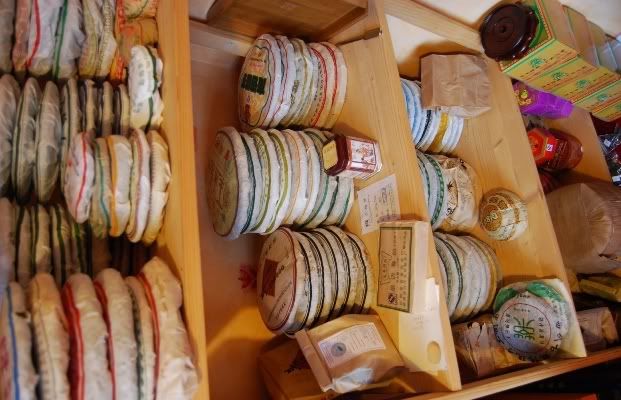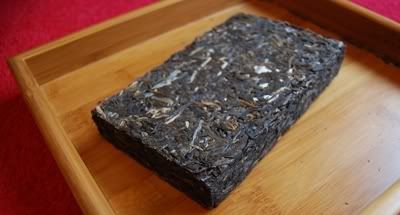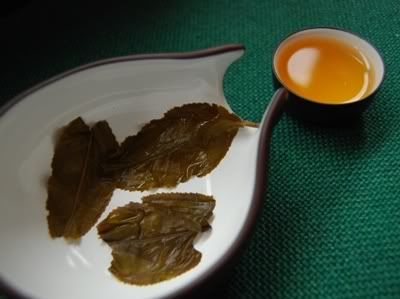Amusingly enough, the rickety shelves tipped forward the other day sending a bunch of Dayi cakes hurtling to their doom. I call it the "China Post simulator".
The Hailanghao Jingmai brick is the little green-inked chap to the left of centre, above.
The Hailanghao Jingmai brick is the little green-inked chap to the left of centre, above.
Sultry. Brooding. Pouting. This brick promises happiness. I'm slightly disconcerted by the $10 price tag (Yunnan Sourcing), which is often indicative that one shouldn't expect too much. As the old saying goes, paying lots is not a guarantee of quality, but you can be sure that if you're paying little, you're getting lower quality. (This is not an invitation to charge $40 for all of your teas!)
This little 250g brick comes from a total of 900kg - fans of higher mathematics will astutely note that this means just 3600 bricks were made. It is one of 2.5 productions from Hailanghao in 2008 (including the Bulang Zhi Xing / Star of Bulang collaborative effort). Yunnan geographers will know that Jingmai is way out there in the Mekong (Lancang) county area, itself within the Simao region.
This little 250g brick comes from a total of 900kg - fans of higher mathematics will astutely note that this means just 3600 bricks were made. It is one of 2.5 productions from Hailanghao in 2008 (including the Bulang Zhi Xing / Star of Bulang collaborative effort). Yunnan geographers will know that Jingmai is way out there in the Mekong (Lancang) county area, itself within the Simao region.
Following the vendor's product description, I say that this was a Hailanghao production, but that's not strictly true. The wrapper makes no mention of Hailanghao. More accurately, for those pedants out there like me, it's a Mingxiangyayuan production (the small private company that makes the Hailanghao brand).
The actual name of this brick is "Jingmai Chunyun", meaning "Jingmai Spring-Charm" (yun as in yunxiang). It's a lovely name, and a pity that it wasn't translated by the vendor.
Even more lovely, the wrapper says "Menghai xian [Menghai county] Yezhuang [a village's name] shaungli [double-beauty] zhi chachang [tea factory product]". It's lovely that a little village is credited on the wrapper - Yezhuang means "leaf village". It's humble and unassuming.
(Lei also liked the use of the word "chang", meaning humble "factory", rather than the more modern, and vulgar, hyperbolic affected names, such as "corporation" or "company". It's just a small village, and its name is befittingly humble. In a China where almost every tiny company is named in a grand, overweening fashion, some discretion and humility are rare and to be appreciated.)
The actual name of this brick is "Jingmai Chunyun", meaning "Jingmai Spring-Charm" (yun as in yunxiang). It's a lovely name, and a pity that it wasn't translated by the vendor.
Even more lovely, the wrapper says "Menghai xian [Menghai county] Yezhuang [a village's name] shaungli [double-beauty] zhi chachang [tea factory product]". It's lovely that a little village is credited on the wrapper - Yezhuang means "leaf village". It's humble and unassuming.
(Lei also liked the use of the word "chang", meaning humble "factory", rather than the more modern, and vulgar, hyperbolic affected names, such as "corporation" or "company". It's just a small village, and its name is befittingly humble. In a China where almost every tiny company is named in a grand, overweening fashion, some discretion and humility are rare and to be appreciated.)
I would, given its humble roots, really love to love this tea. However, the quality is a bit low, and it's rather hard to be too affectionate.
It has a savoury opening, with a heavy, candy lengxiang [cooling scent], and has a corresponding savoury flavour - reminding me of sweet potatoes. It seems the term de jour for Jingmai is "nutty", and I suspect that refers to this savoury character typical of the region.
It's quite thin, underpowered, and really needs pushing hard. I will be satisfied with a single brick, and seem to enjoy the wrapper and the tea's "feeling" more than the actual quality of the leaf itself.
It has a savoury opening, with a heavy, candy lengxiang [cooling scent], and has a corresponding savoury flavour - reminding me of sweet potatoes. It seems the term de jour for Jingmai is "nutty", and I suspect that refers to this savoury character typical of the region.
It's quite thin, underpowered, and really needs pushing hard. I will be satisfied with a single brick, and seem to enjoy the wrapper and the tea's "feeling" more than the actual quality of the leaf itself.





What a collection of tasty puerh you have!
ReplyDeleteI also thought 08 HLH Jingmai to be so so. I rarely miss out on writing my notes on teas but somehow I can't find my notes on this tea. Strange.
By the way, how do you organize your tea shelf? Samples on top, extra beengs on the middle and ageable tongs and boxes at the bottom? How humid is your storage condition?
I laughed out loud at work. Your joke popped up as I scroll down the screen. Didn't expect it. "China Post simulator"... good one. I so got caught today at work. :D
Thanks for another good review.
Tongs on the bottom shelves, certainly, for anchoring the shelves! I couldn't get high enough, but there are another two shelves above. The cakes are organised by factory.
ReplyDeleteSamples go on another set of shelves, in four large wicker baskets:
1. Shengpu to try
2. Other tea to try
3. Remainders of samples I've already tried
4. Shengpu I really want to try soon!
This is just a temporary arrangement, carried over from our old house. We've just moved in to a new place, and I'm going to be fitting some more permanent shelves for these chaps to avoid further China Post simulation cycles. :)
How do you organise yours?
Toodlepip,
Hobbes
Hobbes,
ReplyDeleteMy feelings on this tea were a bit different. I really enjoyed this and have brewed it on many occasions. I'd be curious to know what your ratio of leaf to water was. I normally push 7-8 grams per 100ml of water. Perhaps a little more leaf is in order? Then again, it could just be one of the lovely distinctions that give each and every one of us our own personal sense of taste. Thanks for the more thorough translations on the wrapper. Hope all is well. Sorry to hear about the shelf taking a spill. It's always a bit jarring to see it happen to one's own collection.
jamus~
Dear Jamus,
ReplyDeleteGood question! It's must be somewhere around 7-12g for my 10cl pot, but then the amount of water would be less than that - maybe 80ml?
Maybe I'll push it a bit harder as you suggest. It would be fine if this turned out to be worth keeping, as $10 isn't a lot.
Thanks for the kind words regarding the spillage - I'm not too precious about my tea, though. Any tea that wants to survive my clumsy hands has to be robust!
All the best,
Hobbes
I don't like to "push" teas too much. Especially if it is one you intend to age. A thin flimsy tea in its youth will certainly be even more so when aged. But then again, you don't intend to age this tea. :D Great post!
ReplyDeleteSo true, Bill. It's only going to go downhill in terms of potency.
ReplyDeleteToodlepip,
Hobbes
Dear Joannah,
ReplyDeleteI very much appreciate you taking the time to comment, and am glad that the Half-Dipper is treating you well!
Toodlepip,
Hobbes